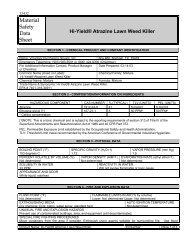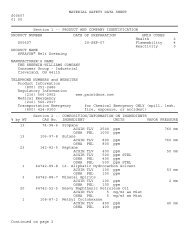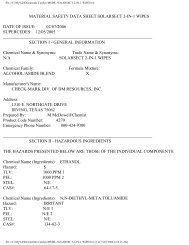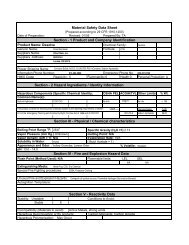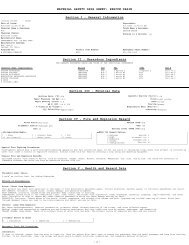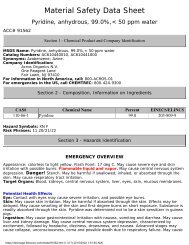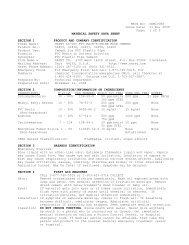MATERIAL SAFETY DATA SHEET: UNISOL PLUS ... - services
MATERIAL SAFETY DATA SHEET: UNISOL PLUS ... - services
MATERIAL SAFETY DATA SHEET: UNISOL PLUS ... - services
Create successful ePaper yourself
Turn your PDF publications into a flip-book with our unique Google optimized e-Paper software.
<strong>MATERIAL</strong> <strong>SAFETY</strong> <strong>DATA</strong> <strong>SHEET</strong>: <strong>UNISOL</strong> <strong>PLUS</strong><br />
Primary Routes of Entry<br />
[√] Inhalation [√] Ingestion [√] Absorption<br />
Emergency First Aid Procedures:<br />
Inhalation:<br />
Remove from the area to fresh air. If not breathing, clear the airway and start mouth to mouth artificial respiration. Get immediate medical attention.<br />
Eye Contact:<br />
Immediately rinse the eyes with water. Remove any contact lenses and continue flushing for at least 15 minutes. Hold the eyelids apart to ensure rinsing of<br />
the entire surface of the eyes and lids with water. Get immediate medical attention.<br />
Skin Contact:<br />
Immediately remove contaminated clothing and shoes. Flush affected areas with large amounts of water for 20 to 30 minutes. Get immediate medical attention.<br />
Discard clothing and shoes.<br />
Ingestion:<br />
Give 3 to 4 glasses of water, but DO NOT induce vomiting. If vomiting occurs, give fluids again. Get immediate medical attention. Do not give anything by<br />
mouth to an unconscious or convulsing person.<br />
Notes to Physician:<br />
Chlorinated Hydrocarbons may sensitize the heart to Epinephrine and other circulating catecholamines so that arrhythmias may occur. Careful consideration of<br />
this potential adverse effect should precede administration of epinephrine or other cardiac stimulants and the selection of bronchodilators. Ingestion and<br />
subsequent vomiting of this product can lead to aspiration of the product into the lungs which can cause damage and may be fatal. Depending on the amount<br />
ingested and retained as well as the toxicity of the product, gastric lavage should be considered. Keep patient's head below hips to prevent pulmonary<br />
aspiration. If comatose, a cuffed endotracheal tube will prevent aspiration.<br />
Product Contains Chemicals Listed as Carcinogen or Potential Carcinogen By:<br />
Section VI - Toxicity Information<br />
[√] IARC [√] NTP [√] OSHA [√] ACGIH [√] Other<br />
VOC content: 0.6% by weight; 9.6 g/L<br />
TETRACHLOROETHYLENE<br />
IHL-RAT LC 50 : 34,200 mg/m3/8h 3.<br />
ORL-RAT LD 50 : 2629 mg/kg 3.<br />
SKN-RBT LD 50 : >3228 mg/kg 3.<br />
SKN-RBT SDT: 500 mg/24h mild 3.<br />
EYE-RBT SDT: 500 mg/24h mild 3.<br />
EYE-RBT: severe 4.<br />
ACGIH: A3 - Confirmed animal carcinogen with unknown relevance to humans<br />
IARC group 2A<br />
NTP: Part B. Reasonably anticipated to be human carcinogen.<br />
CARBON TETRACHLORIDE<br />
ORL-RAT LD 50 : 2350 mg/kg 4.<br />
IHL-RAT LC 50 : 8000 ppm 4.<br />
SKN-RAT LD 50 : 5070 mg/kg 4.<br />
ACGIH: A2 - Suspected human carcinogen.<br />
IARC group 2B<br />
NTP: Part B. Reasonably anticipated to be human carcinogen.<br />
METHYLENE CHLORIDE<br />
ORL-HMN LDL o : 357 mg/kg 3.<br />
ORL-RAT LD 50 : 1600 mg/kg 3.<br />
SKN-RBT SDT: 800 mg/24h severe 3.<br />
EYE-RBT SDT: 162 mg moderate 3.<br />
IHL-RAT LC 50 : 52 g/m3 3.<br />
IHL-HMN TCL o : 500 ppm/8h 3.<br />
Tumorigenic data<br />
IHL-RAT TCL o : 3500 PPM/6H/2Y-I 3.<br />
Reproductive data<br />
IHL-RAT TCL o : 4500 ppm/24h/female 1-17 days after conception 3.<br />
Methylene Chloride has been evaluated for possible cancer causing effects in laboratory animals. Inhalation studies at concentrations of 2000 and 4000 ppm<br />
increased the incidence of malignant liver and lung tumors in mice. Three inhalation studies of rats have shown increased incidence of benign mammary gland<br />
tumors in female rats at concentrations of 500 ppm and above and increases in benign mammary gland tumors in males at concentrations of 1500 ppm and above.<br />
Rats exposed to 50 and 200 ppm via inhalation showed no increased incidence of tumors. Mice and rats exposed by ingestion at levels up to 250 mg/kg/day<br />
lifetime and hamsters exposed via inhalation to concentrations up to 3500 ppm lifetime did not show an increased incidence of tumors. 4.<br />
Epidemiology studies of 751 humans chronically exposed to Methylene Chloride in the workplace of which 252 were exposed for a minimum of 20 years did not<br />
demonstrate any increase in deaths caused by cancer or cardiac problems. A second study of 2227 workers confirmed these results. 4.<br />
Laboratory animal studies on mice, rats, and rabbits have been conducted to evaluate the potential reproductive and developmental effects of Methylene<br />
Chloride exposures. Methlyene Chloride exposure has not been shown to cause teratogenic effects (birth defects) in experimental animals. 4.<br />
ACGIH group A3: confirmed animal carcinogen with unknown relevance to humans<br />
IARC group 2B: animal sufficient evidence; human inadequate evidence<br />
NTP: reasonably anticipated to be a human carcinogen<br />
PROPYLENE OXIDE<br />
ORL-RAT LD 50 : 380 mg/kg 4.<br />
IHL-RAT LC 50 : 4000 ppm/4h 4.<br />
SKN-RBT LD 50 : 1500 uL/kg 4.<br />
SKN-RBT SDT: 50 mg/6m severe 4.<br />
EYE-RBT SDT: 20 mg/24h moderate 4.<br />
ACGIH group A3: confirmed animal carcinogen with unknown relevance to humans<br />
IARC group 2B: animal sufficient evidence; human inadequate evidence<br />
NTP: reasonably anticipated to be a human carcinogen<br />
Section VII - Reactivity Data<br />
2 of 4



